Low Cost Airline Development and its Impact in Singapore
VerifiedAdded on 2021/06/15
|9
|2236
|176
Essay
AI Summary
This essay provides a comprehensive overview of the development and impact of low-cost airlines in Singapore. It traces the historical roots of low-cost carriers, highlighting their emergence and evolution, particularly within the context of the Southeast Asian market. The essay details the operations of key players like Tigerair, Jetstar Asia, and Scoot, and analyzes their influence on the traditional airline sector. A significant portion of the essay is dedicated to exploring the impact of these airlines on the tourism industry, discussing changes to tourism products, economic implications, and increased demand. Furthermore, the essay examines the operational changes adopted by low-cost airlines, including marketing strategies, route selection, and fleet utilization. The essay concludes with a forecast for the future of low-cost airline operations in Singapore, considering technological advancements, government initiatives, and market demands. The role of these airlines in boosting the Singapore economy and the tourism sector is also highlighted. The essay also looks at the shift in airline operations and predicted future trends. The essay also looks at the shift in airline operations and predicted future trends.
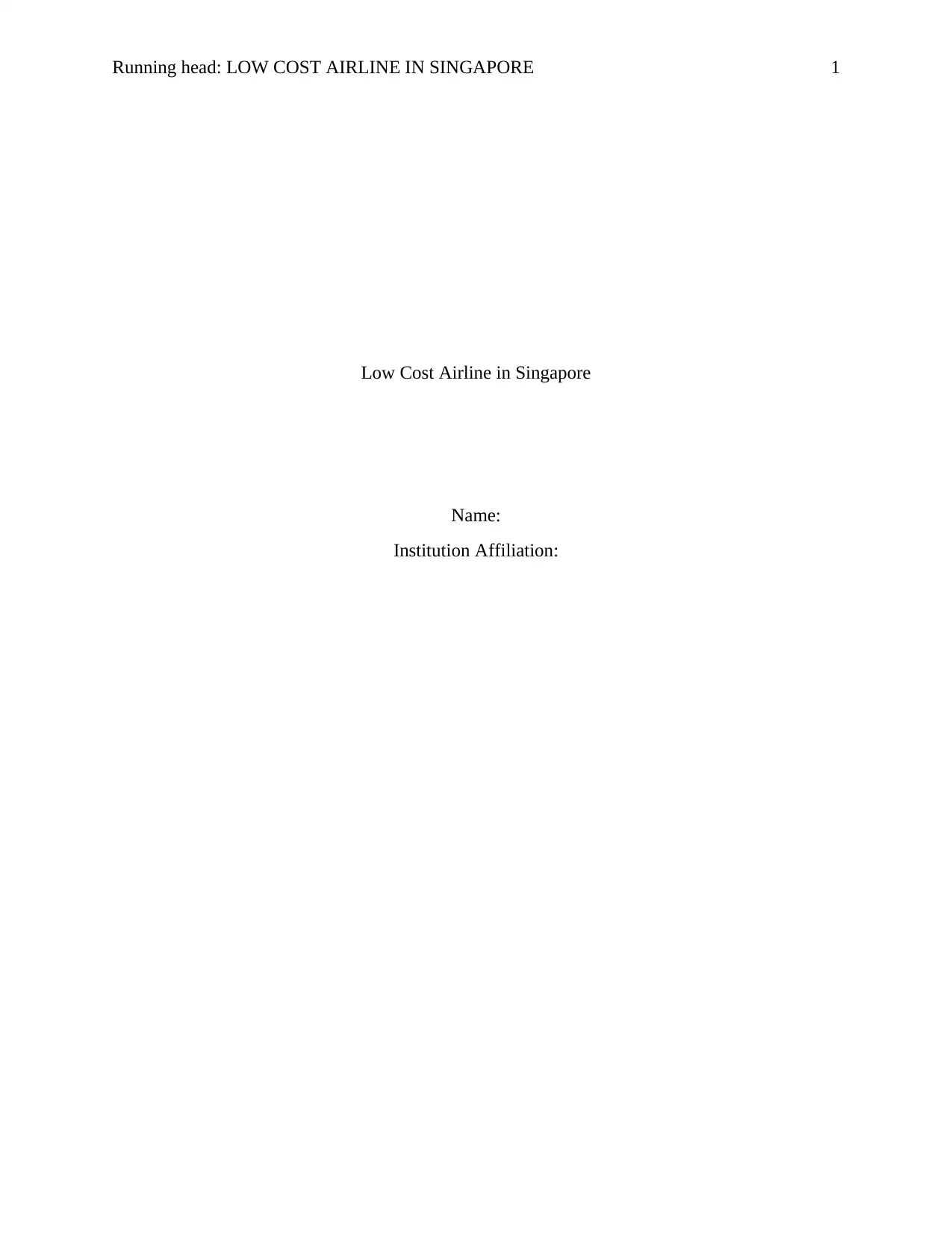
Running head: LOW COST AIRLINE IN SINGAPORE 1
Low Cost Airline in Singapore
Name:
Institution Affiliation:
Low Cost Airline in Singapore
Name:
Institution Affiliation:
Paraphrase This Document
Need a fresh take? Get an instant paraphrase of this document with our AI Paraphraser
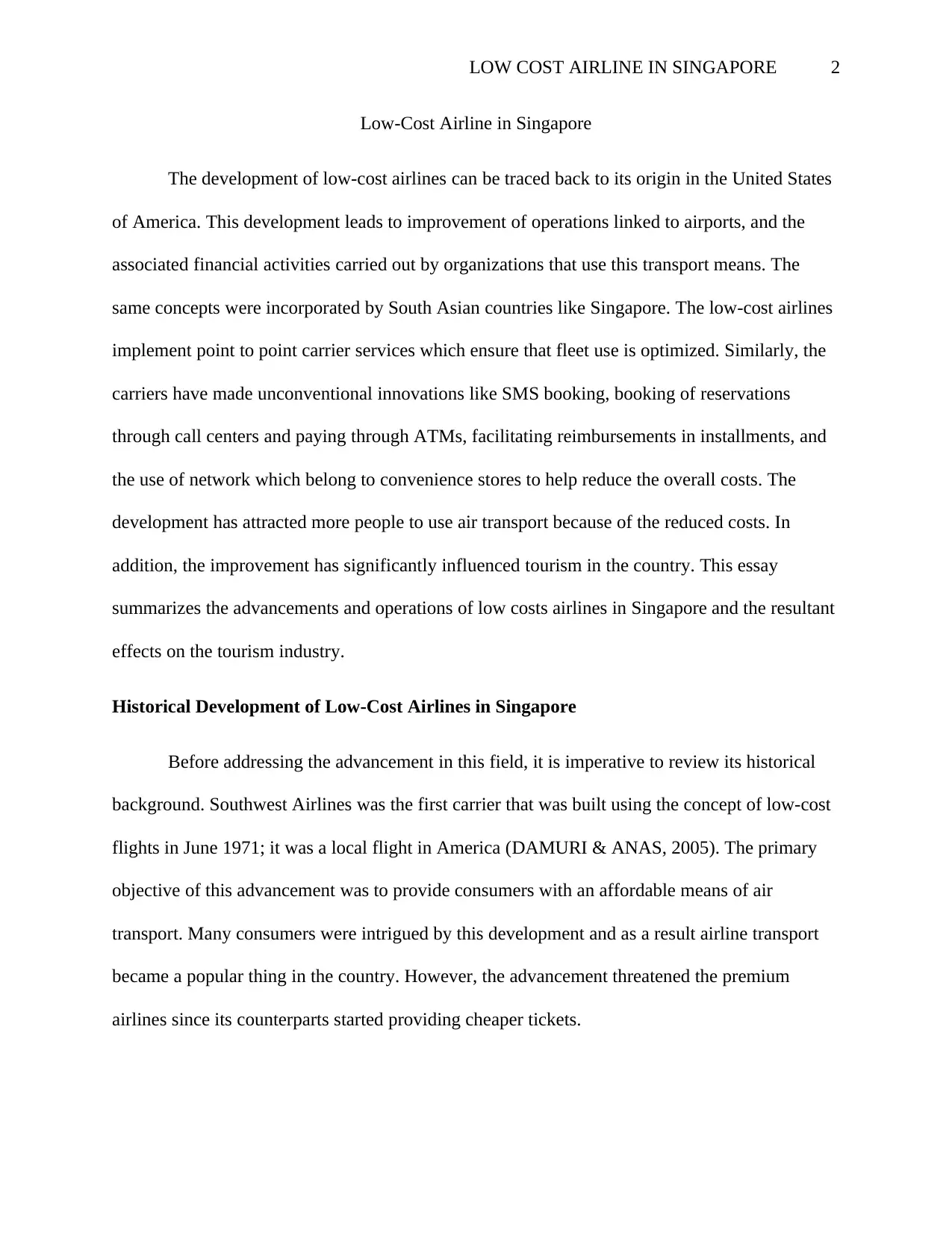
LOW COST AIRLINE IN SINGAPORE 2
Low-Cost Airline in Singapore
The development of low-cost airlines can be traced back to its origin in the United States
of America. This development leads to improvement of operations linked to airports, and the
associated financial activities carried out by organizations that use this transport means. The
same concepts were incorporated by South Asian countries like Singapore. The low-cost airlines
implement point to point carrier services which ensure that fleet use is optimized. Similarly, the
carriers have made unconventional innovations like SMS booking, booking of reservations
through call centers and paying through ATMs, facilitating reimbursements in installments, and
the use of network which belong to convenience stores to help reduce the overall costs. The
development has attracted more people to use air transport because of the reduced costs. In
addition, the improvement has significantly influenced tourism in the country. This essay
summarizes the advancements and operations of low costs airlines in Singapore and the resultant
effects on the tourism industry.
Historical Development of Low-Cost Airlines in Singapore
Before addressing the advancement in this field, it is imperative to review its historical
background. Southwest Airlines was the first carrier that was built using the concept of low-cost
flights in June 1971; it was a local flight in America (DAMURI & ANAS, 2005). The primary
objective of this advancement was to provide consumers with an affordable means of air
transport. Many consumers were intrigued by this development and as a result airline transport
became a popular thing in the country. However, the advancement threatened the premium
airlines since its counterparts started providing cheaper tickets.
Low-Cost Airline in Singapore
The development of low-cost airlines can be traced back to its origin in the United States
of America. This development leads to improvement of operations linked to airports, and the
associated financial activities carried out by organizations that use this transport means. The
same concepts were incorporated by South Asian countries like Singapore. The low-cost airlines
implement point to point carrier services which ensure that fleet use is optimized. Similarly, the
carriers have made unconventional innovations like SMS booking, booking of reservations
through call centers and paying through ATMs, facilitating reimbursements in installments, and
the use of network which belong to convenience stores to help reduce the overall costs. The
development has attracted more people to use air transport because of the reduced costs. In
addition, the improvement has significantly influenced tourism in the country. This essay
summarizes the advancements and operations of low costs airlines in Singapore and the resultant
effects on the tourism industry.
Historical Development of Low-Cost Airlines in Singapore
Before addressing the advancement in this field, it is imperative to review its historical
background. Southwest Airlines was the first carrier that was built using the concept of low-cost
flights in June 1971; it was a local flight in America (DAMURI & ANAS, 2005). The primary
objective of this advancement was to provide consumers with an affordable means of air
transport. Many consumers were intrigued by this development and as a result airline transport
became a popular thing in the country. However, the advancement threatened the premium
airlines since its counterparts started providing cheaper tickets.
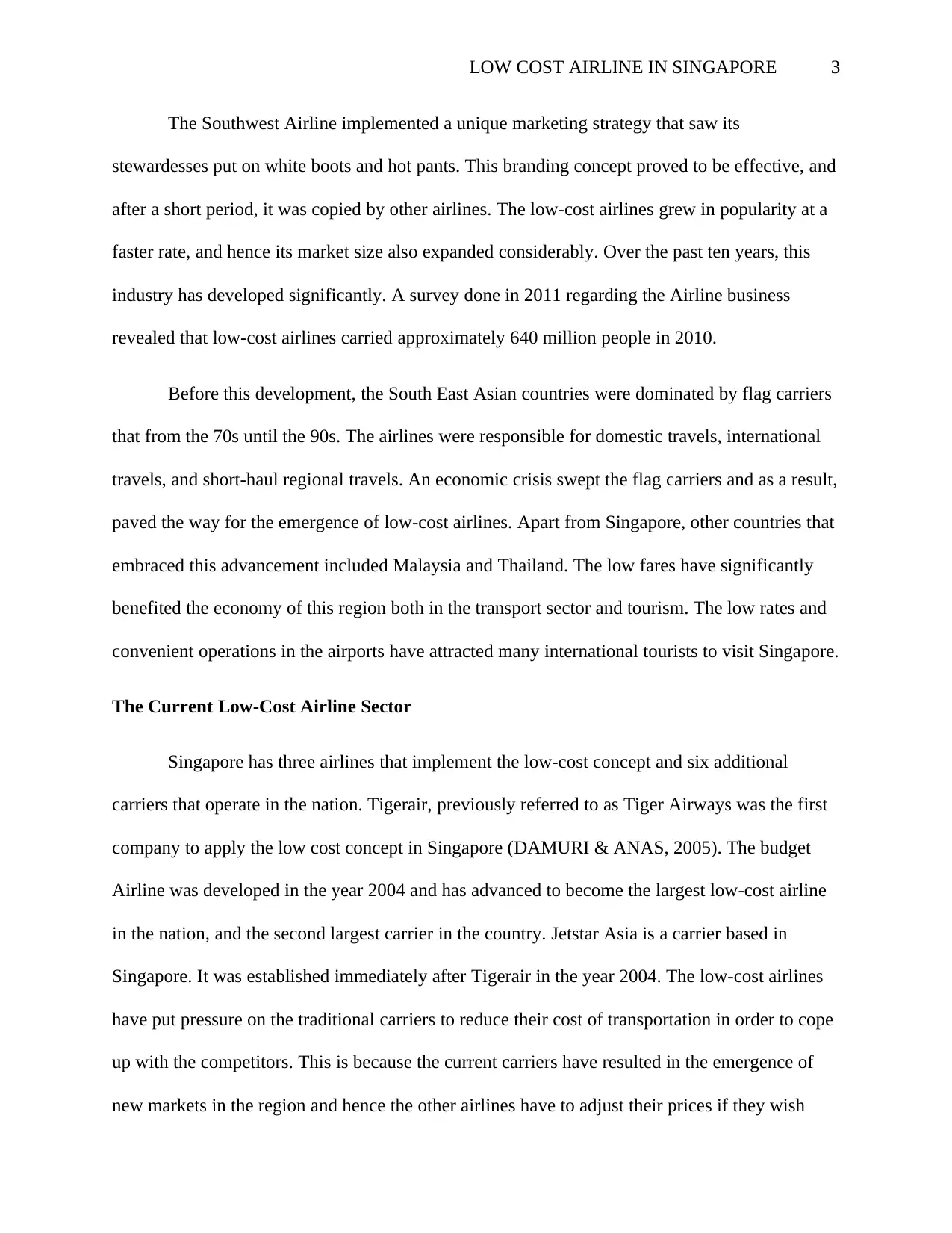
LOW COST AIRLINE IN SINGAPORE 3
The Southwest Airline implemented a unique marketing strategy that saw its
stewardesses put on white boots and hot pants. This branding concept proved to be effective, and
after a short period, it was copied by other airlines. The low-cost airlines grew in popularity at a
faster rate, and hence its market size also expanded considerably. Over the past ten years, this
industry has developed significantly. A survey done in 2011 regarding the Airline business
revealed that low-cost airlines carried approximately 640 million people in 2010.
Before this development, the South East Asian countries were dominated by flag carriers
that from the 70s until the 90s. The airlines were responsible for domestic travels, international
travels, and short-haul regional travels. An economic crisis swept the flag carriers and as a result,
paved the way for the emergence of low-cost airlines. Apart from Singapore, other countries that
embraced this advancement included Malaysia and Thailand. The low fares have significantly
benefited the economy of this region both in the transport sector and tourism. The low rates and
convenient operations in the airports have attracted many international tourists to visit Singapore.
The Current Low-Cost Airline Sector
Singapore has three airlines that implement the low-cost concept and six additional
carriers that operate in the nation. Tigerair, previously referred to as Tiger Airways was the first
company to apply the low cost concept in Singapore (DAMURI & ANAS, 2005). The budget
Airline was developed in the year 2004 and has advanced to become the largest low-cost airline
in the nation, and the second largest carrier in the country. Jetstar Asia is a carrier based in
Singapore. It was established immediately after Tigerair in the year 2004. The low-cost airlines
have put pressure on the traditional carriers to reduce their cost of transportation in order to cope
up with the competitors. This is because the current carriers have resulted in the emergence of
new markets in the region and hence the other airlines have to adjust their prices if they wish
The Southwest Airline implemented a unique marketing strategy that saw its
stewardesses put on white boots and hot pants. This branding concept proved to be effective, and
after a short period, it was copied by other airlines. The low-cost airlines grew in popularity at a
faster rate, and hence its market size also expanded considerably. Over the past ten years, this
industry has developed significantly. A survey done in 2011 regarding the Airline business
revealed that low-cost airlines carried approximately 640 million people in 2010.
Before this development, the South East Asian countries were dominated by flag carriers
that from the 70s until the 90s. The airlines were responsible for domestic travels, international
travels, and short-haul regional travels. An economic crisis swept the flag carriers and as a result,
paved the way for the emergence of low-cost airlines. Apart from Singapore, other countries that
embraced this advancement included Malaysia and Thailand. The low fares have significantly
benefited the economy of this region both in the transport sector and tourism. The low rates and
convenient operations in the airports have attracted many international tourists to visit Singapore.
The Current Low-Cost Airline Sector
Singapore has three airlines that implement the low-cost concept and six additional
carriers that operate in the nation. Tigerair, previously referred to as Tiger Airways was the first
company to apply the low cost concept in Singapore (DAMURI & ANAS, 2005). The budget
Airline was developed in the year 2004 and has advanced to become the largest low-cost airline
in the nation, and the second largest carrier in the country. Jetstar Asia is a carrier based in
Singapore. It was established immediately after Tigerair in the year 2004. The low-cost airlines
have put pressure on the traditional carriers to reduce their cost of transportation in order to cope
up with the competitors. This is because the current carriers have resulted in the emergence of
new markets in the region and hence the other airlines have to adjust their prices if they wish
⊘ This is a preview!⊘
Do you want full access?
Subscribe today to unlock all pages.

Trusted by 1+ million students worldwide
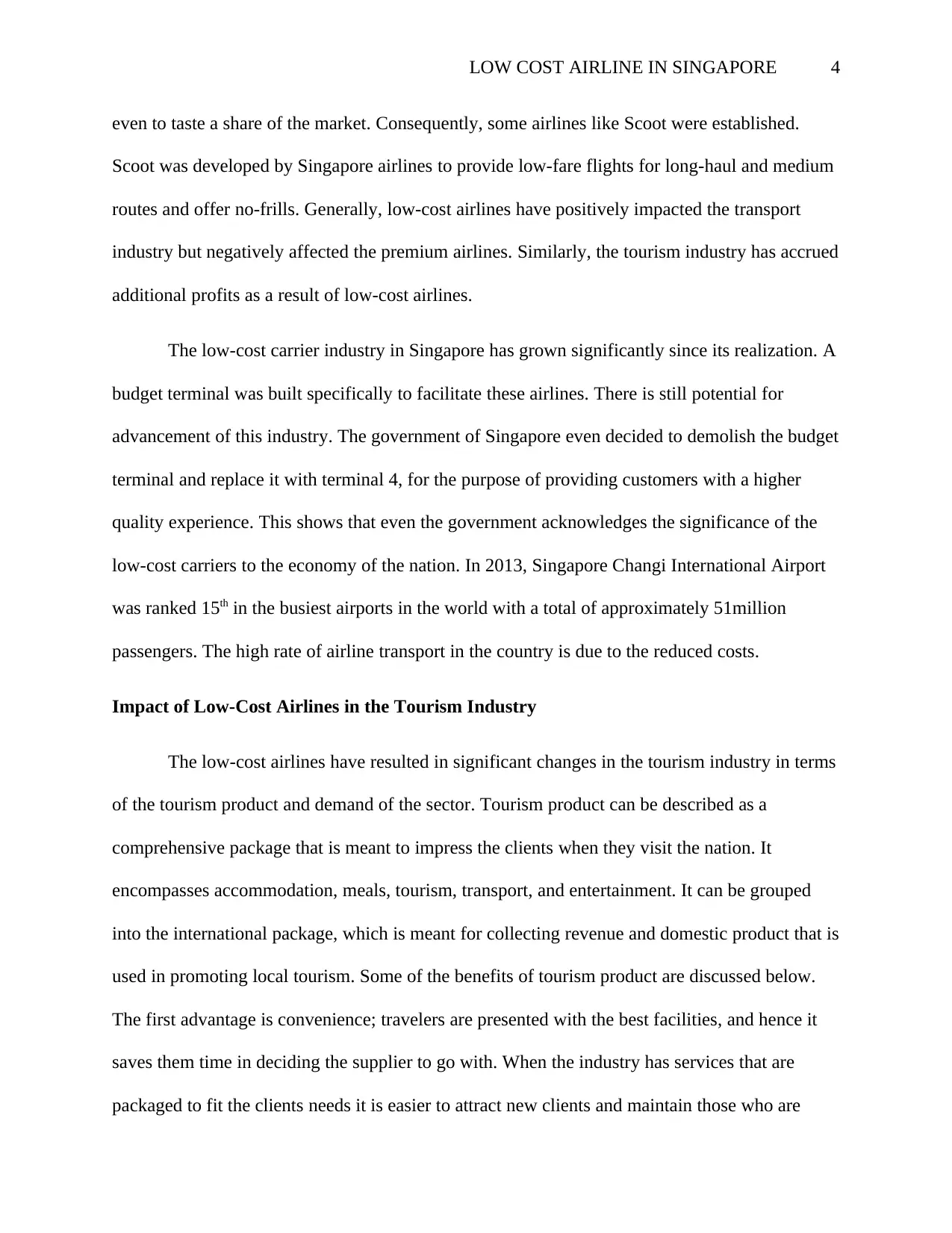
LOW COST AIRLINE IN SINGAPORE 4
even to taste a share of the market. Consequently, some airlines like Scoot were established.
Scoot was developed by Singapore airlines to provide low-fare flights for long-haul and medium
routes and offer no-frills. Generally, low-cost airlines have positively impacted the transport
industry but negatively affected the premium airlines. Similarly, the tourism industry has accrued
additional profits as a result of low-cost airlines.
The low-cost carrier industry in Singapore has grown significantly since its realization. A
budget terminal was built specifically to facilitate these airlines. There is still potential for
advancement of this industry. The government of Singapore even decided to demolish the budget
terminal and replace it with terminal 4, for the purpose of providing customers with a higher
quality experience. This shows that even the government acknowledges the significance of the
low-cost carriers to the economy of the nation. In 2013, Singapore Changi International Airport
was ranked 15th in the busiest airports in the world with a total of approximately 51million
passengers. The high rate of airline transport in the country is due to the reduced costs.
Impact of Low-Cost Airlines in the Tourism Industry
The low-cost airlines have resulted in significant changes in the tourism industry in terms
of the tourism product and demand of the sector. Tourism product can be described as a
comprehensive package that is meant to impress the clients when they visit the nation. It
encompasses accommodation, meals, tourism, transport, and entertainment. It can be grouped
into the international package, which is meant for collecting revenue and domestic product that is
used in promoting local tourism. Some of the benefits of tourism product are discussed below.
The first advantage is convenience; travelers are presented with the best facilities, and hence it
saves them time in deciding the supplier to go with. When the industry has services that are
packaged to fit the clients needs it is easier to attract new clients and maintain those who are
even to taste a share of the market. Consequently, some airlines like Scoot were established.
Scoot was developed by Singapore airlines to provide low-fare flights for long-haul and medium
routes and offer no-frills. Generally, low-cost airlines have positively impacted the transport
industry but negatively affected the premium airlines. Similarly, the tourism industry has accrued
additional profits as a result of low-cost airlines.
The low-cost carrier industry in Singapore has grown significantly since its realization. A
budget terminal was built specifically to facilitate these airlines. There is still potential for
advancement of this industry. The government of Singapore even decided to demolish the budget
terminal and replace it with terminal 4, for the purpose of providing customers with a higher
quality experience. This shows that even the government acknowledges the significance of the
low-cost carriers to the economy of the nation. In 2013, Singapore Changi International Airport
was ranked 15th in the busiest airports in the world with a total of approximately 51million
passengers. The high rate of airline transport in the country is due to the reduced costs.
Impact of Low-Cost Airlines in the Tourism Industry
The low-cost airlines have resulted in significant changes in the tourism industry in terms
of the tourism product and demand of the sector. Tourism product can be described as a
comprehensive package that is meant to impress the clients when they visit the nation. It
encompasses accommodation, meals, tourism, transport, and entertainment. It can be grouped
into the international package, which is meant for collecting revenue and domestic product that is
used in promoting local tourism. Some of the benefits of tourism product are discussed below.
The first advantage is convenience; travelers are presented with the best facilities, and hence it
saves them time in deciding the supplier to go with. When the industry has services that are
packaged to fit the clients needs it is easier to attract new clients and maintain those who are
Paraphrase This Document
Need a fresh take? Get an instant paraphrase of this document with our AI Paraphraser
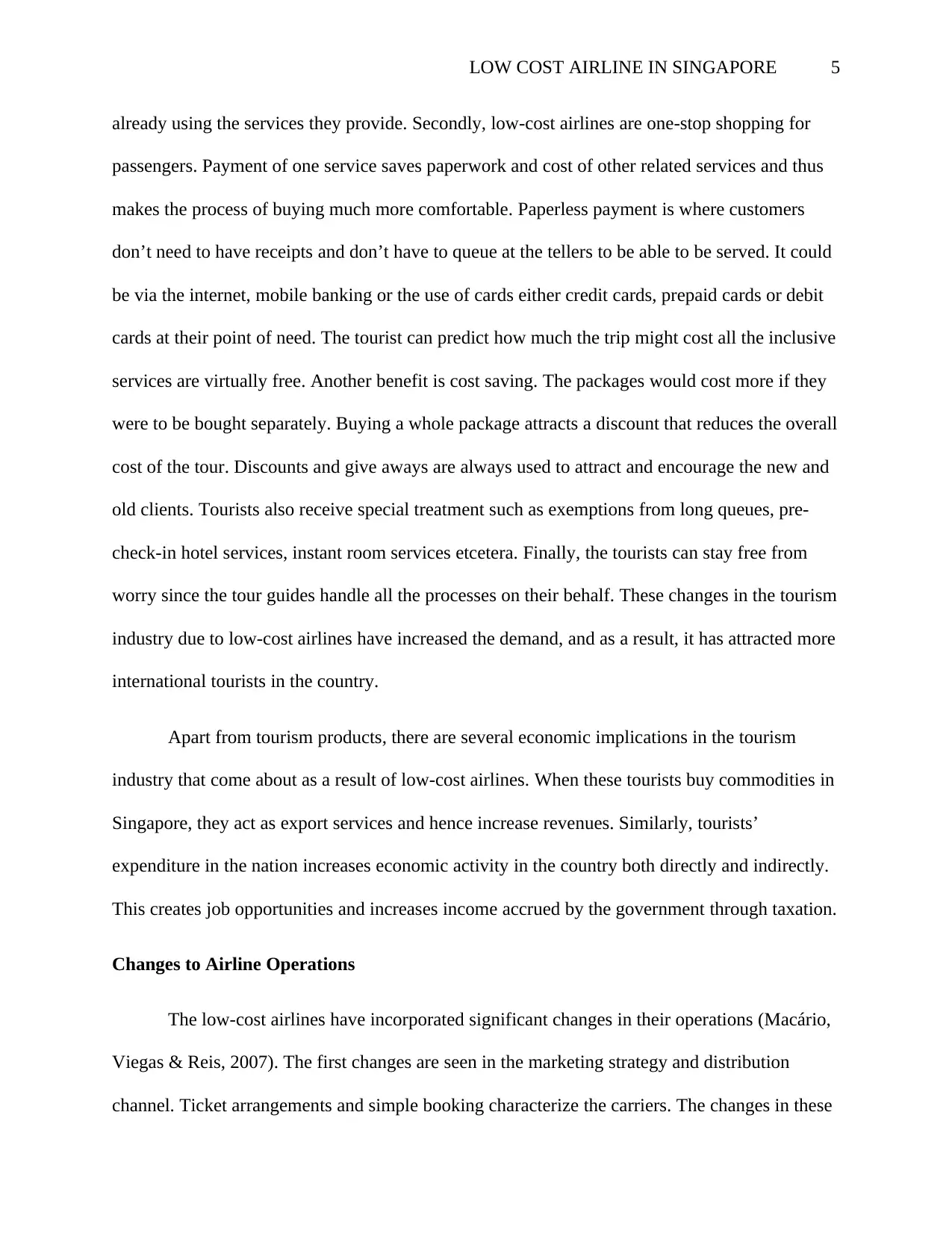
LOW COST AIRLINE IN SINGAPORE 5
already using the services they provide. Secondly, low-cost airlines are one-stop shopping for
passengers. Payment of one service saves paperwork and cost of other related services and thus
makes the process of buying much more comfortable. Paperless payment is where customers
don’t need to have receipts and don’t have to queue at the tellers to be able to be served. It could
be via the internet, mobile banking or the use of cards either credit cards, prepaid cards or debit
cards at their point of need. The tourist can predict how much the trip might cost all the inclusive
services are virtually free. Another benefit is cost saving. The packages would cost more if they
were to be bought separately. Buying a whole package attracts a discount that reduces the overall
cost of the tour. Discounts and give aways are always used to attract and encourage the new and
old clients. Tourists also receive special treatment such as exemptions from long queues, pre-
check-in hotel services, instant room services etcetera. Finally, the tourists can stay free from
worry since the tour guides handle all the processes on their behalf. These changes in the tourism
industry due to low-cost airlines have increased the demand, and as a result, it has attracted more
international tourists in the country.
Apart from tourism products, there are several economic implications in the tourism
industry that come about as a result of low-cost airlines. When these tourists buy commodities in
Singapore, they act as export services and hence increase revenues. Similarly, tourists’
expenditure in the nation increases economic activity in the country both directly and indirectly.
This creates job opportunities and increases income accrued by the government through taxation.
Changes to Airline Operations
The low-cost airlines have incorporated significant changes in their operations (Macário,
Viegas & Reis, 2007). The first changes are seen in the marketing strategy and distribution
channel. Ticket arrangements and simple booking characterize the carriers. The changes in these
already using the services they provide. Secondly, low-cost airlines are one-stop shopping for
passengers. Payment of one service saves paperwork and cost of other related services and thus
makes the process of buying much more comfortable. Paperless payment is where customers
don’t need to have receipts and don’t have to queue at the tellers to be able to be served. It could
be via the internet, mobile banking or the use of cards either credit cards, prepaid cards or debit
cards at their point of need. The tourist can predict how much the trip might cost all the inclusive
services are virtually free. Another benefit is cost saving. The packages would cost more if they
were to be bought separately. Buying a whole package attracts a discount that reduces the overall
cost of the tour. Discounts and give aways are always used to attract and encourage the new and
old clients. Tourists also receive special treatment such as exemptions from long queues, pre-
check-in hotel services, instant room services etcetera. Finally, the tourists can stay free from
worry since the tour guides handle all the processes on their behalf. These changes in the tourism
industry due to low-cost airlines have increased the demand, and as a result, it has attracted more
international tourists in the country.
Apart from tourism products, there are several economic implications in the tourism
industry that come about as a result of low-cost airlines. When these tourists buy commodities in
Singapore, they act as export services and hence increase revenues. Similarly, tourists’
expenditure in the nation increases economic activity in the country both directly and indirectly.
This creates job opportunities and increases income accrued by the government through taxation.
Changes to Airline Operations
The low-cost airlines have incorporated significant changes in their operations (Macário,
Viegas & Reis, 2007). The first changes are seen in the marketing strategy and distribution
channel. Ticket arrangements and simple booking characterize the carriers. The changes in these
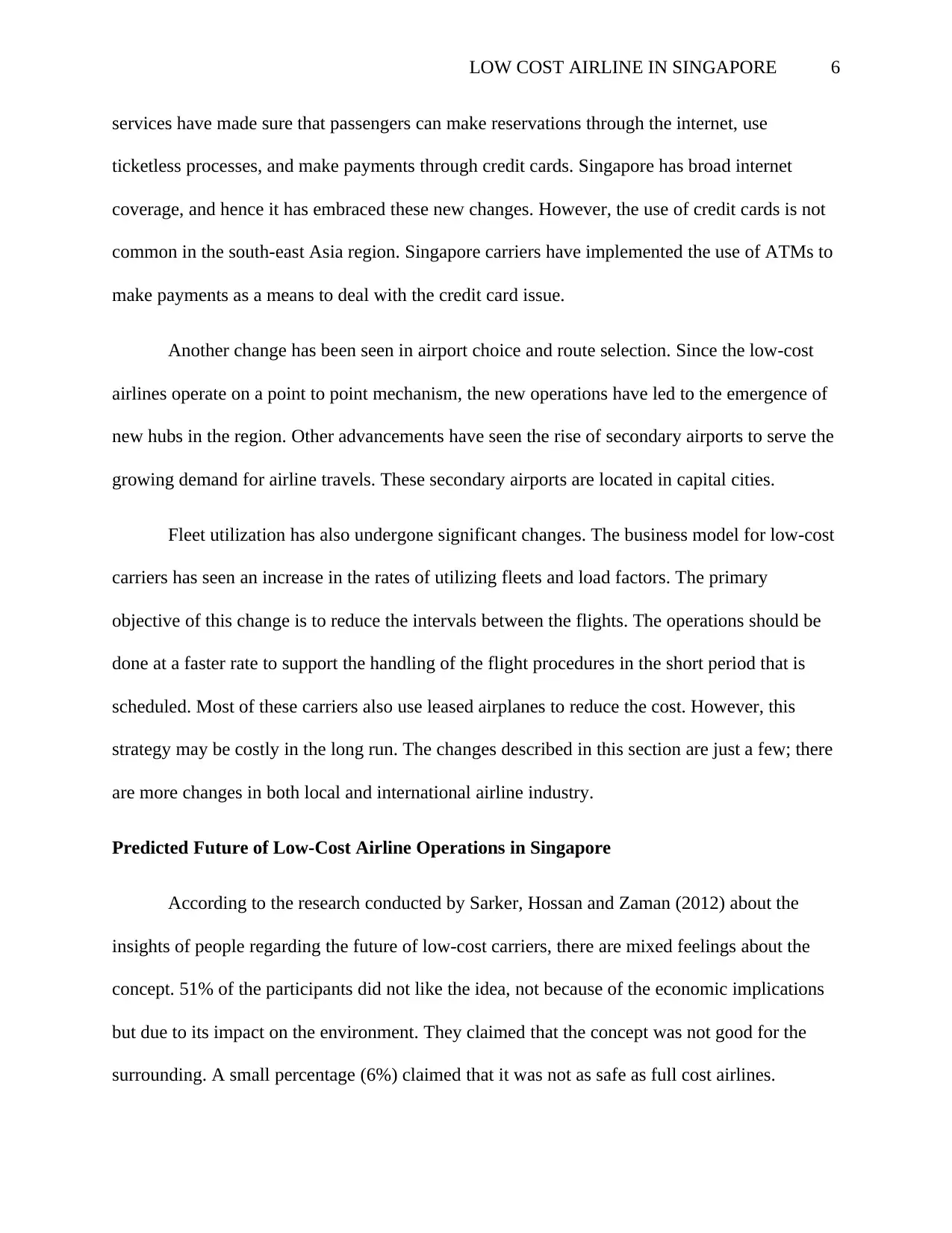
LOW COST AIRLINE IN SINGAPORE 6
services have made sure that passengers can make reservations through the internet, use
ticketless processes, and make payments through credit cards. Singapore has broad internet
coverage, and hence it has embraced these new changes. However, the use of credit cards is not
common in the south-east Asia region. Singapore carriers have implemented the use of ATMs to
make payments as a means to deal with the credit card issue.
Another change has been seen in airport choice and route selection. Since the low-cost
airlines operate on a point to point mechanism, the new operations have led to the emergence of
new hubs in the region. Other advancements have seen the rise of secondary airports to serve the
growing demand for airline travels. These secondary airports are located in capital cities.
Fleet utilization has also undergone significant changes. The business model for low-cost
carriers has seen an increase in the rates of utilizing fleets and load factors. The primary
objective of this change is to reduce the intervals between the flights. The operations should be
done at a faster rate to support the handling of the flight procedures in the short period that is
scheduled. Most of these carriers also use leased airplanes to reduce the cost. However, this
strategy may be costly in the long run. The changes described in this section are just a few; there
are more changes in both local and international airline industry.
Predicted Future of Low-Cost Airline Operations in Singapore
According to the research conducted by Sarker, Hossan and Zaman (2012) about the
insights of people regarding the future of low-cost carriers, there are mixed feelings about the
concept. 51% of the participants did not like the idea, not because of the economic implications
but due to its impact on the environment. They claimed that the concept was not good for the
surrounding. A small percentage (6%) claimed that it was not as safe as full cost airlines.
services have made sure that passengers can make reservations through the internet, use
ticketless processes, and make payments through credit cards. Singapore has broad internet
coverage, and hence it has embraced these new changes. However, the use of credit cards is not
common in the south-east Asia region. Singapore carriers have implemented the use of ATMs to
make payments as a means to deal with the credit card issue.
Another change has been seen in airport choice and route selection. Since the low-cost
airlines operate on a point to point mechanism, the new operations have led to the emergence of
new hubs in the region. Other advancements have seen the rise of secondary airports to serve the
growing demand for airline travels. These secondary airports are located in capital cities.
Fleet utilization has also undergone significant changes. The business model for low-cost
carriers has seen an increase in the rates of utilizing fleets and load factors. The primary
objective of this change is to reduce the intervals between the flights. The operations should be
done at a faster rate to support the handling of the flight procedures in the short period that is
scheduled. Most of these carriers also use leased airplanes to reduce the cost. However, this
strategy may be costly in the long run. The changes described in this section are just a few; there
are more changes in both local and international airline industry.
Predicted Future of Low-Cost Airline Operations in Singapore
According to the research conducted by Sarker, Hossan and Zaman (2012) about the
insights of people regarding the future of low-cost carriers, there are mixed feelings about the
concept. 51% of the participants did not like the idea, not because of the economic implications
but due to its impact on the environment. They claimed that the concept was not good for the
surrounding. A small percentage (6%) claimed that it was not as safe as full cost airlines.
⊘ This is a preview!⊘
Do you want full access?
Subscribe today to unlock all pages.

Trusted by 1+ million students worldwide
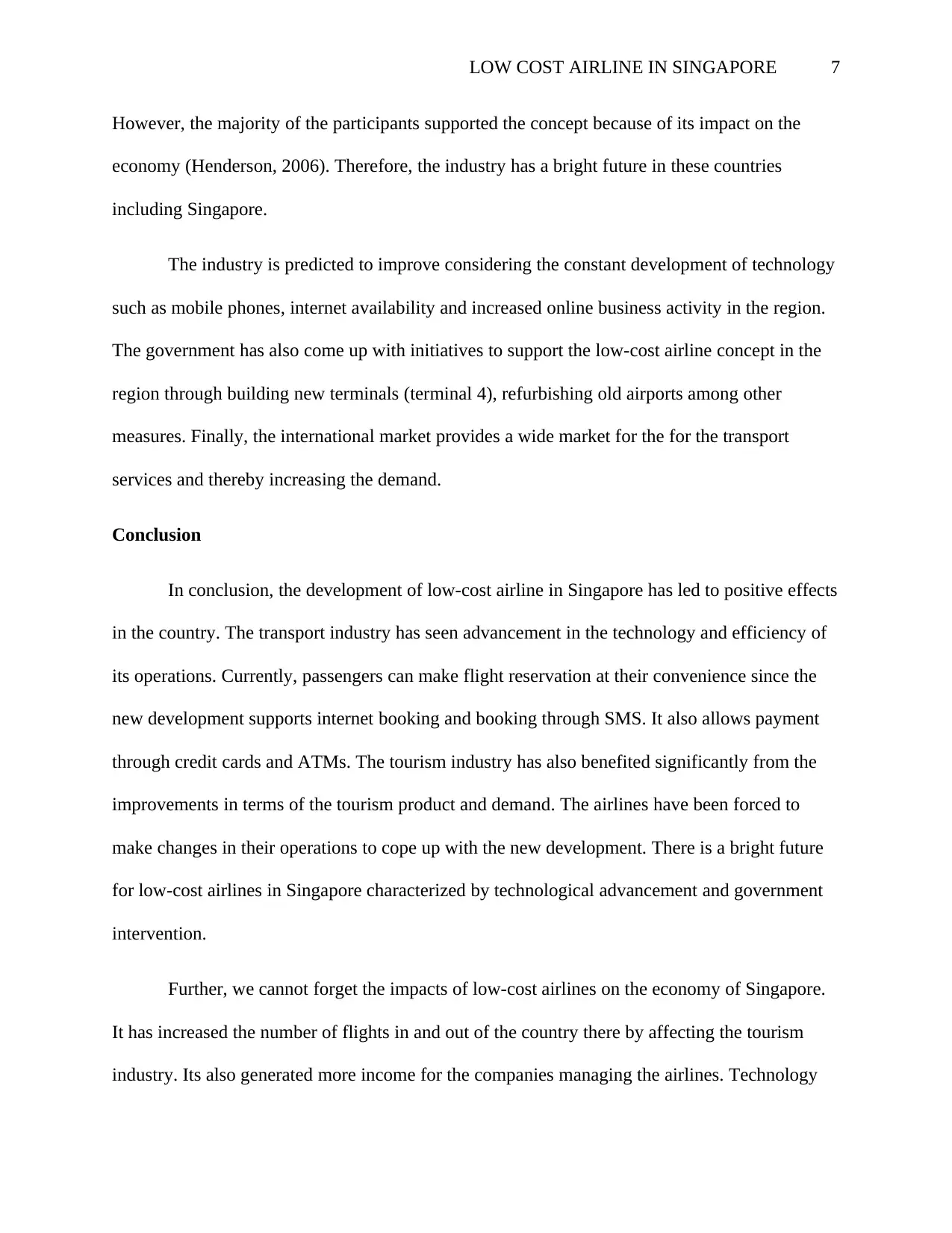
LOW COST AIRLINE IN SINGAPORE 7
However, the majority of the participants supported the concept because of its impact on the
economy (Henderson, 2006). Therefore, the industry has a bright future in these countries
including Singapore.
The industry is predicted to improve considering the constant development of technology
such as mobile phones, internet availability and increased online business activity in the region.
The government has also come up with initiatives to support the low-cost airline concept in the
region through building new terminals (terminal 4), refurbishing old airports among other
measures. Finally, the international market provides a wide market for the for the transport
services and thereby increasing the demand.
Conclusion
In conclusion, the development of low-cost airline in Singapore has led to positive effects
in the country. The transport industry has seen advancement in the technology and efficiency of
its operations. Currently, passengers can make flight reservation at their convenience since the
new development supports internet booking and booking through SMS. It also allows payment
through credit cards and ATMs. The tourism industry has also benefited significantly from the
improvements in terms of the tourism product and demand. The airlines have been forced to
make changes in their operations to cope up with the new development. There is a bright future
for low-cost airlines in Singapore characterized by technological advancement and government
intervention.
Further, we cannot forget the impacts of low-cost airlines on the economy of Singapore.
It has increased the number of flights in and out of the country there by affecting the tourism
industry. Its also generated more income for the companies managing the airlines. Technology
However, the majority of the participants supported the concept because of its impact on the
economy (Henderson, 2006). Therefore, the industry has a bright future in these countries
including Singapore.
The industry is predicted to improve considering the constant development of technology
such as mobile phones, internet availability and increased online business activity in the region.
The government has also come up with initiatives to support the low-cost airline concept in the
region through building new terminals (terminal 4), refurbishing old airports among other
measures. Finally, the international market provides a wide market for the for the transport
services and thereby increasing the demand.
Conclusion
In conclusion, the development of low-cost airline in Singapore has led to positive effects
in the country. The transport industry has seen advancement in the technology and efficiency of
its operations. Currently, passengers can make flight reservation at their convenience since the
new development supports internet booking and booking through SMS. It also allows payment
through credit cards and ATMs. The tourism industry has also benefited significantly from the
improvements in terms of the tourism product and demand. The airlines have been forced to
make changes in their operations to cope up with the new development. There is a bright future
for low-cost airlines in Singapore characterized by technological advancement and government
intervention.
Further, we cannot forget the impacts of low-cost airlines on the economy of Singapore.
It has increased the number of flights in and out of the country there by affecting the tourism
industry. Its also generated more income for the companies managing the airlines. Technology
Paraphrase This Document
Need a fresh take? Get an instant paraphrase of this document with our AI Paraphraser

LOW COST AIRLINE IN SINGAPORE 8
improvement of internet ticketing has also improved the services provided by the airlines in
Singapore. Though technology for the use of credit cards is not prominent it is advisable and
recommended for them to encourage the users.
improvement of internet ticketing has also improved the services provided by the airlines in
Singapore. Though technology for the use of credit cards is not prominent it is advisable and
recommended for them to encourage the users.
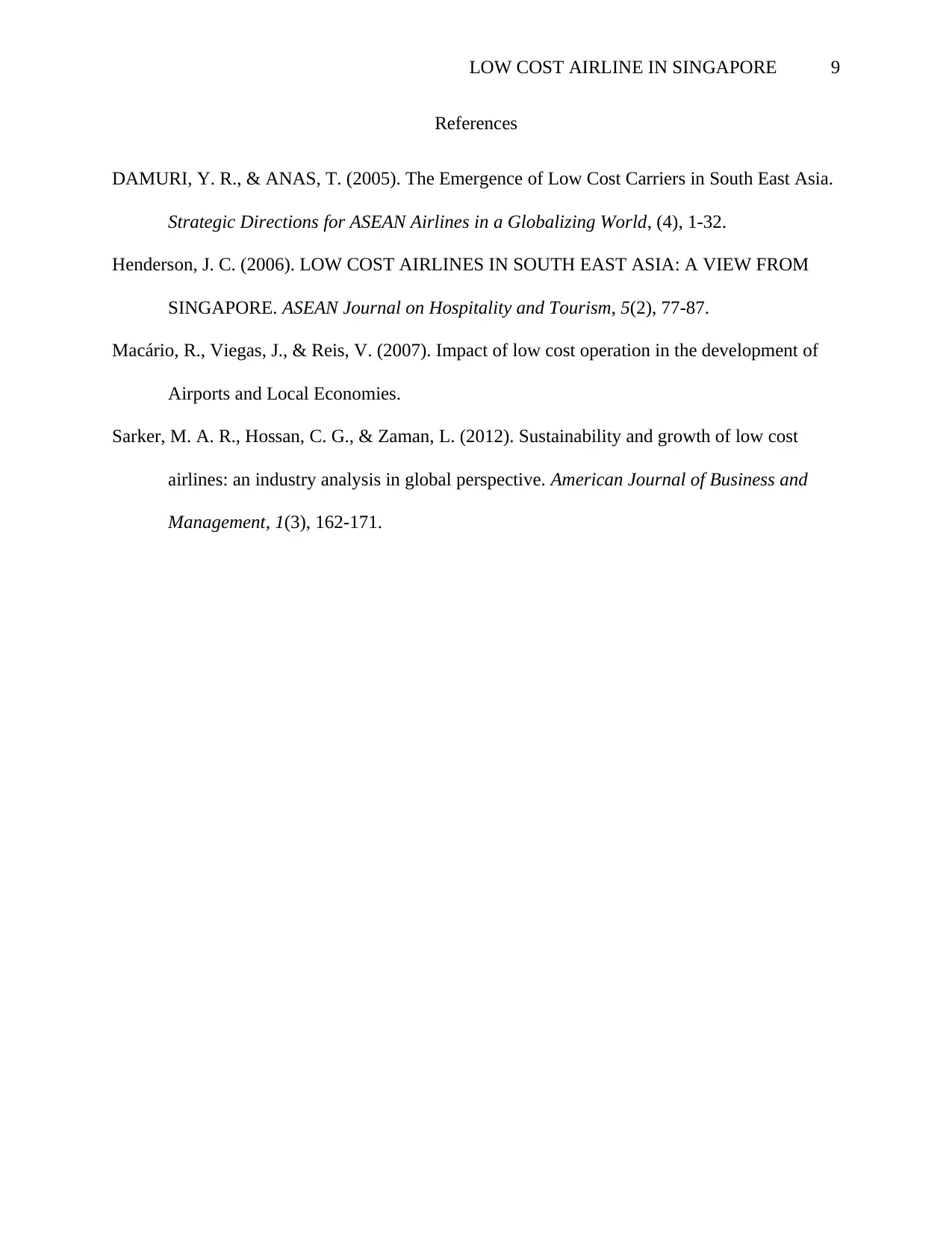
LOW COST AIRLINE IN SINGAPORE 9
References
DAMURI, Y. R., & ANAS, T. (2005). The Emergence of Low Cost Carriers in South East Asia.
Strategic Directions for ASEAN Airlines in a Globalizing World, (4), 1-32.
Henderson, J. C. (2006). LOW COST AIRLINES IN SOUTH EAST ASIA: A VIEW FROM
SINGAPORE. ASEAN Journal on Hospitality and Tourism, 5(2), 77-87.
Macário, R., Viegas, J., & Reis, V. (2007). Impact of low cost operation in the development of
Airports and Local Economies.
Sarker, M. A. R., Hossan, C. G., & Zaman, L. (2012). Sustainability and growth of low cost
airlines: an industry analysis in global perspective. American Journal of Business and
Management, 1(3), 162-171.
References
DAMURI, Y. R., & ANAS, T. (2005). The Emergence of Low Cost Carriers in South East Asia.
Strategic Directions for ASEAN Airlines in a Globalizing World, (4), 1-32.
Henderson, J. C. (2006). LOW COST AIRLINES IN SOUTH EAST ASIA: A VIEW FROM
SINGAPORE. ASEAN Journal on Hospitality and Tourism, 5(2), 77-87.
Macário, R., Viegas, J., & Reis, V. (2007). Impact of low cost operation in the development of
Airports and Local Economies.
Sarker, M. A. R., Hossan, C. G., & Zaman, L. (2012). Sustainability and growth of low cost
airlines: an industry analysis in global perspective. American Journal of Business and
Management, 1(3), 162-171.
⊘ This is a preview!⊘
Do you want full access?
Subscribe today to unlock all pages.

Trusted by 1+ million students worldwide
1 out of 9
Related Documents
Your All-in-One AI-Powered Toolkit for Academic Success.
+13062052269
info@desklib.com
Available 24*7 on WhatsApp / Email
![[object Object]](/_next/static/media/star-bottom.7253800d.svg)
Unlock your academic potential
Copyright © 2020–2025 A2Z Services. All Rights Reserved. Developed and managed by ZUCOL.





